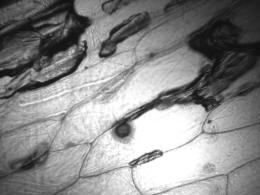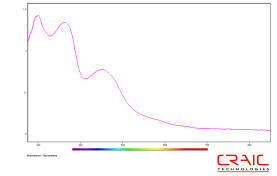Nanobiotechnology Instrumentation

Microspectrophotometers are used to analyze nanobiotechnology products by reflectance, absorbance and fluorescence

Microspectra
UV-visible-NIR microscopy and microspectroscopy for analysis of nanotechnology.
Nanobiotechnology applies the principles of nanotechnology to biotechnology: where the technological products and organisms are derived from biology and agricultural sciences. Products resulting from nanobiotechnology research are used in three major areas: agriculture, biofuels and environmental applications. As such, nanobiotechnology ranges from microarrays where thousands or millions of tests can be conducted on a single device simultaneously, bioengineering and bioremediation.
Able to analyze micro-scale volumes by absorption, reflectance or even fluorescence, microspectrophotometers are easy-to-use and very accurate. Their flexibility and accuracy make them very important for analyzing everything from genetically engineered organisms to sophisticated microarrays.
To learn more about microspectroscopy and nanobiotechnology applications, select one of the following links:
What is a Microspectrophotometer?
Science of Microspectrophotometers
Microfluidic Device Analysis

Microspectrophotometers are used for microplate analysis by reflectance, absorbance and fluorescence

Microspectra
UV-visible-NIR microscopy and microspectroscopy for analysis of any microplate test point..
Microfluidic devices, sometimes called lab-on-a-chip devices, are designed to replicate a series of full-scale chemical and biological reactions on a single micro-scale device. They are sometimes called microelectromechanical systems (MEMS) for their fluid handling capabilities on the microscopic scale. As such, a single device is used replicate a series of chemical reactions but on a microscopic scale. Therefore analytical techniques are required that can measure whether reactions have reached a successful conclusion but of micro-scale volumes.
. Able to analyze micro-scale volumes by absorbance, reflectance or even fluorescence, microspectrophotometers are easy-to-use and very accurate. Their flexibility and accuracy make them very important when developing or using custom microfluidic devices.
To learn more about microspectroscopy and microfluidic device development and testing, select one of the following links:
What is a Microspectrophotometer?
Science of Microspectrophotometers
FPD Inspection
![]()
Microspectrophotometers are used to test the color and intensity of each FPD pixel
![]()
Typical test spectra from a flat panel display
FPD Inspection: Color, chromaticity, luminance, spectroscopy and film thickness of pixels and light sources.
Flat Panel Display, or FPD, is a device that consist of a series of colored lighted areas arranged in a pattern. Controlled with electronics, they can be used as light sources or as high resolution displays for everything from televisions to computers. There are many different designs resulting in different quality control challenges.
Due to the nature of flat panel displays, they are manufactured with hundreds of rows of microscopic "pixels" on a surface. In the next generation of FPD, such as those used in MP3 players and mobile phones, these pixels can be as small as 10 microns across. Quality control of both the components and completed FPD devices is done by optical microspectroscopy. Microspectrometers, such as those made by CRAIC Technologies, are used to measure the color and the intensity of the output from individual pixels, from groups of pixels and from the light sources. They are can be used to map the color and intensity outputs of individual pixels or even entire displays. This is important as manufacturers of flat panel displays need to make sure that all the different types of pixels are the same color and brightness. A microspectrophotometer does this quickly and easily.
To learn more about microspectroscopy and FPD analysis and testing, select one of the following links:
What is a Microspectrophotometer?
Science of Microspectrophotometers
Colorimetry of Pixels and Displays
Relative Intensity Measurements
508 FPD™ Spectrophotometers for Microscopes and Probe Stations
Biotechnology Instrumentation

Microspectrophotometers are used to analyze biotechnology products by reflectance, absorbance and fluorescence

Microspectra
UV-visible-NIR microscopy and microspectroscopy for analysis of biotechnology.
Biotechnology applies the principles of technology to biology: where the technological products and organisms are derived from biology and agricultural sciences. Products resulting from biotechnology research are used in three major areas: agriculture, biofuels and environmental applications. As such, biotechnology ranges from microarrays where thousands or millions of tests can be conducted on a single device simultaneously to bioengineering and bioremediation.
Due to the microscopic volumes of the materials to be analyzed, microspectrophotometers are the perfect tool. Able to analyze micro-scale volumes by absorption, reflectance or even fluorescence, these tools are easy-to-use and very accurate. Their flexibility and accuracy make them very importance for analyzing everything from genetically engineered organisms to sophisticated microarrays.
To learn more about microspectroscopy and biotechnology applications, select one of the following links:
What is a Microspectrophotometer?
Science of Microspectrophotometers
The Microphotometer is designed to measure the luminous intensity of microscopic samples or microscopic areas of larger objects. The photometer unit is designed to attach to an open photoport of an optical microscope. Depending upon the configuration, it is capable of measuring the light intensity of microscopic samples by transmission, absorbance, reflectance, fluorescence, emission and polarization illumination.
A CRAIC Technologies™ microphotometer is a purpose-built system that allows you to analyze UV-visible-NIR range optical intensity non-destructively and with no sample contact. Capable of analyzing even sub-micron areas, they are also capable of color digital imaging. Designed for ease-of-use, they are durable instruments designed for microscale analysis.
To learn more about microphotometry and microphotometers, select one of the following links:
CRAIC CoalPro III™ Microscope Photometers
CRAIC GeoImager™ Microscope Imaging Photometer
We invite you to discover our revolutionary technologies that include a range of microphotometers, microspectrophotometers, UV-visible-NIR microscopes, Raman microspectrometers, Traceable Standards, microphotometer accessories and software. We further invite you to experience our exceptional service and technical support.


